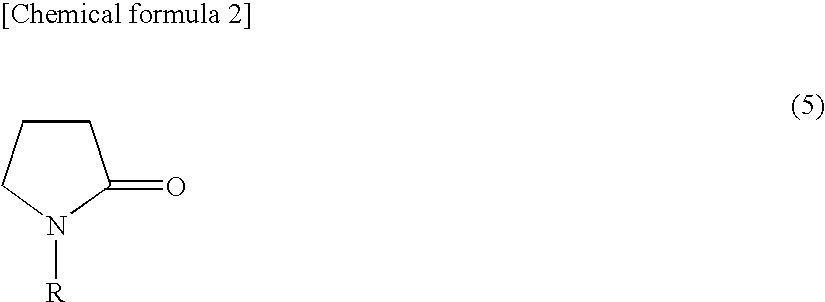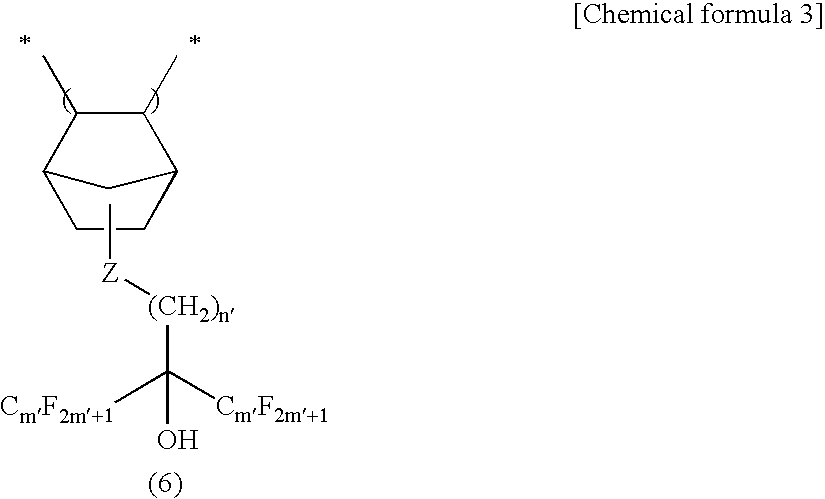Material for forming resist-protecting film for immersion exposure process, resist-protecting film made of such material, and method for forming resist pattern using such resist-protec- ting film
a resist-protecting film and immersion exposure technology, which is applied in the field of resist-protective film materials, can solve the problems of reducing the focal depth width, undergoing liquid invasion, and shortening the wavelength of light sources, so as to improve the durability of resist films
- Summary
- Abstract
- Description
- Claims
- Application Information
AI Technical Summary
Benefits of technology
Problems solved by technology
Method used
Image
Examples
example 2
[0228] The amount of monoethanolamine was reduced from the resist protective film forming material for liquid immersion lithography used in Example 1 to prepare the material, the pH value of which was 2.49.
[0229] With an exception that this resist protective film forming material of pH 2.49 was used, the resist patterns obtained in the same manner as that in the Example 4 as described later, of which 130 nm line-and-space was 1:1, was observed under scanning electron microscope (SEM). The result showed that the pattern profile indicated superior pattern shapes with negligible reduction in thickness of the patterned film and no fluctuation. The sensitivity to exposing light beam (Esize) was 13.21 mJ / cm2 and a variation from the sensitivity in the usual dry process was 2.6% and a variation from the sensitivity in the case where fluorinated liquid was not dripped was negligible.
example 3
[0230] In the same manner as that of the Example 1, the resist protective film was formed and the patterning light beam was irradiated (exposed). Next, perfluoro(2-butyl tetrahydrofuran), a fluorinated liquid, was dripped on the resist film at 23° C. for one minute while the silicon wafer with the resist film covered on it was being turned in the liquid immersion lithography process. In this step of the actual manufacturing process, the light beam is irradiated on the film with completely immersed in the liquid. However, based on the previous analysis on the liquid immersion lithography process, it was demonstrated that exposure by the optical system was completely performed. This might be established theoretically and therefore, it has been simply configured so that the light beam was irradiated on the resist film in advance and the fluorinated liquid, namely the refractive index liquid (liquid immersion liquid) is applied on the resist film after exposure to evaluate only the effe...
example 4
[0232] With an exception that perfluorotripropyleamine, namely a fluorinated liquid, was dripped for one minute in the liquid immersion lithography process, the experience was performed in the same manner as that of the Example 3.
[0233] The resist patters, of which 130 nm line-and-space was 1:1 was observed under running electronic microscopy (SEM). The result showed that the pattern profile indicated superior pattern shapes with no fluctuation. The sensitivity to exposing light (Esize) was 19.03 mJ / cm2 and a variation in sensitivity from the sensitivity in the usual dry process 2.6% and a variation from the case where the fluorinated liquid was not dripped was negligible.
[0234] Evaluation Test 2
Example 5
[0235] 100 parts by weight of resin components represented by the general formulae (46) and (47) used for the positive resist composition in the Example 1, 2.0 parts by weight od triphenylsulfoniumnonafluorobutane sulfonate, namely an acid generating reagent, and 0.6 parts by we...
PUM
| Property | Measurement | Unit |
|---|---|---|
| width | aaaaa | aaaaa |
| micro-sizes | aaaaa | aaaaa |
| wavelengths | aaaaa | aaaaa |
Abstract
Description
Claims
Application Information
 Login to View More
Login to View More - R&D
- Intellectual Property
- Life Sciences
- Materials
- Tech Scout
- Unparalleled Data Quality
- Higher Quality Content
- 60% Fewer Hallucinations
Browse by: Latest US Patents, China's latest patents, Technical Efficacy Thesaurus, Application Domain, Technology Topic, Popular Technical Reports.
© 2025 PatSnap. All rights reserved.Legal|Privacy policy|Modern Slavery Act Transparency Statement|Sitemap|About US| Contact US: help@patsnap.com



